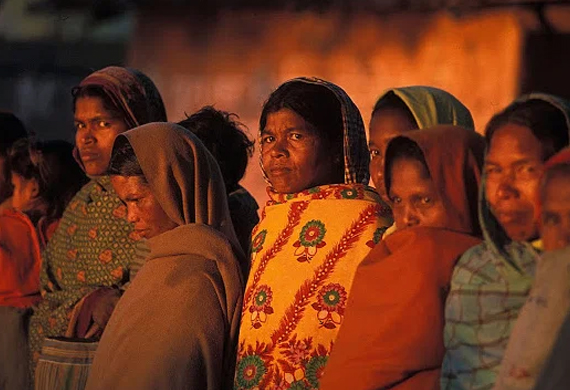
Vulnerable & Unsafe: 13 lakh Women & Girls Went Missing in India in 3 Years
By: WE Staff
India, a country of diversity, culture, and heritage, has also been grappling with a grim reality for centuries – the safety of women. Despite constitutional and legal provisions that guarantee equality and protection for women, the nation ranks disappointingly low in the 'Women, Peace And Security Index 2021', standing at 148 out of 170 countries.
Women's safety in India demands urgent attention and concerted efforts to break free from the shackles of fear and insecurity that continue to haunt them.
The Alarming Statistics
Recent data from the National Crime Records Bureau (NCRB) paints a harrowing picture of the situation. Between 2019 and 2021, over 13 lakh girls and women went missing in the country. Shockingly, this translates to a chilling reality - every four minutes, a girl or woman vanishes somewhere in the country. Tragically, many of these cases remain unresolved, with numerous victims falling prey to human trafficking, sexual violence, forced marriage, or even murder.
The NCRB data further highlights that crime against women has seen a worrisome surge, increasing from 54.6 per 100,000 population in 2016 to 60.9 in 2018. These crimes encompass a wide range of atrocities, including rape, kidnapping, dowry deaths, domestic violence, acid attacks, cybercrimes, and more. To put this into perspective, in 2018 alone, a staggering 3.78 lakh cases of violence and abuse against women were reported in India. This means that every 15 minutes, a woman becomes a victim of some form of violence.
State-wise Disparities
Analyzing the state-wise data from the NCRB, it becomes evident that certain regions are more vulnerable than others. Madhya Pradesh reported the highest number of rape cases in 2018, with 5,450 incidents, followed by Rajasthan (4,335) and Uttar Pradesh (3,946).
The capital city, Delhi, has earned the vile distinction of having the highest rate of crime against women, with a rate of 160.4 per 100,000 population in 2016. In stark contrast, Nagaland recorded the lowest rate of crime against women, with just 7.3 incidents per 100,000 population in 2018.
Missing Women: A Heart-wrenching Reality
The issue of missing women is equally disheartening. Delhi, the national capital, reported a shocking number of missing girls and women, with 61,054 women and 22,919 girls disappearing between 2019 and 2021. Similarly, in Jammu and Kashmir, 8,617 women and 1,148 girls went missing during the same period.
Madhya Pradesh leads the unfortunate tally of missing cases, with a staggering 1,60,180 women and 38,234 girls reported missing. West Bengal closely follows, reporting 1,56,905 missing women and 36,606 missing girls. Maharashtra witnessed 1,78,400 women and 13,033 girls missing, while Odisha and Chhattisgarh reported 70,222 and 16,649 missing women, and 49,116 and 10,817 missing girls, respectively.
What makes women vulnerable?
The disheartening statistics reflect the multifaceted challenges in ensuring women's safety in India. One of the most significant barriers to women's safety is the patriarchal mindset prevalent in society. It manifests in deep-rooted gender bias, objectification of women, and a sense of entitlement among some men, leading to a culture of violence and harassment against women. Additionally, women often face resistance from their families and communities when seeking justice or attempting to break free from abusive relationships.
The lack of proper education and awareness plays a pivotal role in perpetuating the cycle of violence against women. Limited access to education and opportunities restricts women's ability to understand their rights and assert their autonomy. Similarly, the lack of awareness about laws and avenues for seeking help further hinders women's pursuit of justice.
Inadequate implementation and enforcement of laws also contribute to the prevalence of violence against women. While various legislations have been introduced to protect women's rights, there is a gap between the formulation of laws and their effective implementation on the ground. This results in a lack of faith in the judicial system and discourages women from reporting incidents of violence.
Another crucial aspect is the dearth of safe public spaces for women. Poorly lit streets, lack of proper transportation, and inadequate surveillance create an environment conducive to crime and harassment. The fear of harassment and violence restricts women's mobility, limiting their access to education, employment, and other opportunities.
The pervasive influence of corruption and impunity within the law enforcement and judicial systems also hinders justice for women. Cases of violence against women are often not given the seriousness they deserve, leading to low conviction rates and minimal consequences for perpetrators.
Social stigma and victim-blaming further perpetuate the cycle of violence. Women are often blamed and shamed for incidents of violence, leading to underreporting of cases. This not only perpetuates the culture of silence but also emboldens offenders, knowing that they are unlikely to face repercussions for their actions.
Economic dependence is another crucial factor that puts women at risk. Lack of financial independence makes it challenging for women to escape abusive relationships or seek legal recourse, further trapping them in cycles of violence.
Time For Collative & Corrective Measures
The alarming state of women's safety in India is a clarion call for collective action. Every citizen, irrespective of gender, has a moral responsibility to protect and empower women. Strengthening the legal framework, enhancing police and judiciary sensitivity, providing support to survivors, creating safe public spaces, promoting gender equality education, and engaging men as allies are some of the crucial steps toward progress.
It is time for India to rise as a nation that fosters respect, safety, and dignity for its women. Empowered women lead to empowered families and communities, thus propelling the entire nation forward. Together, we can create an inclusive society that values and protects its women and paves the way for a brighter and safer future for all. Let us stand united, breaking the shackles of fear, and work towards making India a safe heven for every woman. Women's safety is not just a concern; it is a collective responsibility, and together, we can bring about transformative change for a safer and more secure tomorrow.


